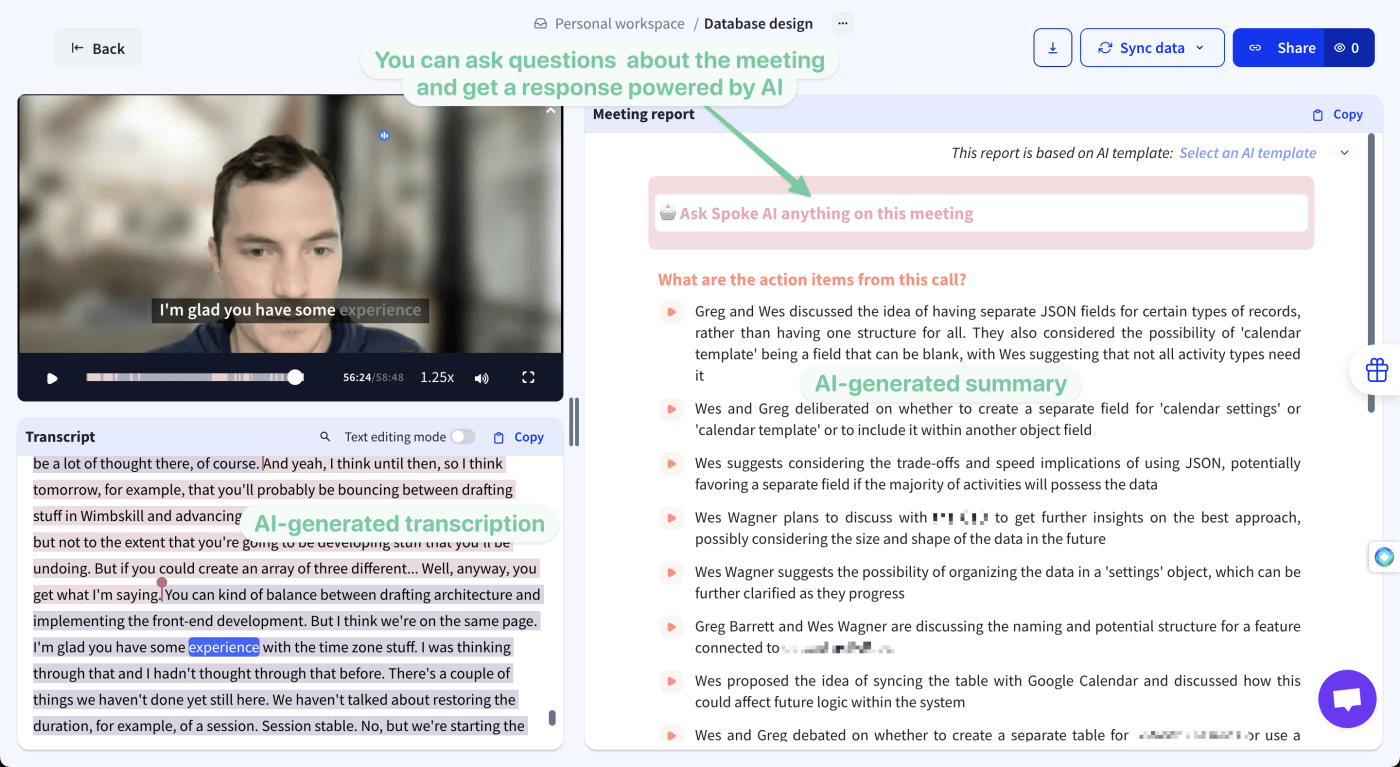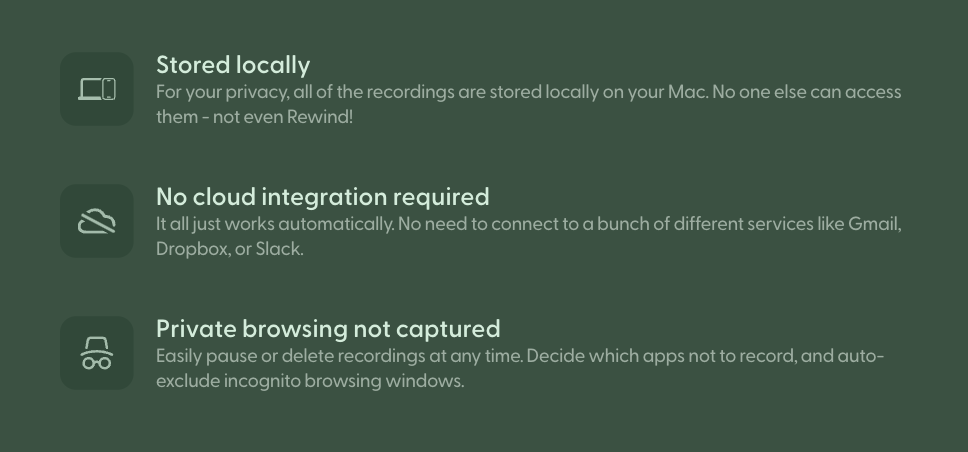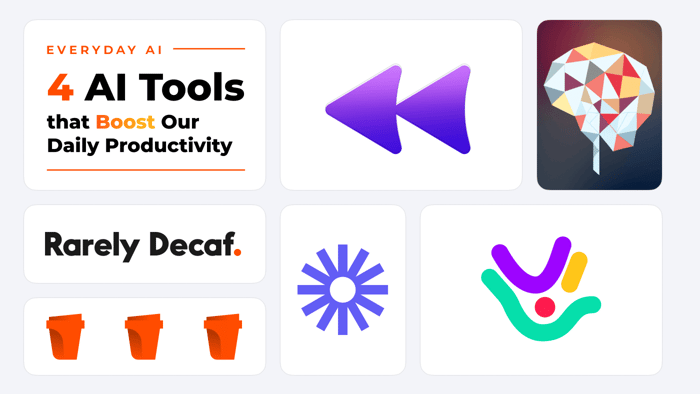At Rarely Decaf, our passion for productivity is matched only by our enthusiasm for leveraging new technology to improve and grow businesses. And arguably, the biggest technology wave of the last year that has unlocked tremendous business potential has been OpenAI's ChatGPT and the evolution of their suite of developer APIs.
As this ecosystem has evolved, businesses have integrated OpenAI's developer APIs into their offerings, developing new AI-powered products and features that save their customers time and money. Yet, with the influx of new tools and services, it can be tough to separate those that can make a real business impact from those that are all buzz and no substance.
Below, we're excited to share a few of the former—AI-powered tools that have transformed our team's day-to-day operations over the last year. We hope that learning a bit more about them, examples of how we use them, and how they work can give you ideas for using these off-the-shelf tools yourself or integrating OpenAI's developer APIs like GPT-3 and GPT-4 into your own business.
TypingMind
What it is
TypingMind is a better version of ChatGPT.
Why we use it daily?
TypingMind uses the same underlying AI technology as ChatGPT, but they offer a few additional features that make it our preferred chatbot to use in our daily work—from improving emails and client messages to improving JavaScript.
- Characters and Saved Prompts: Using TypingMind, we're able to create specific "characters" for different tasks, like "ChatCTO" when we want help thinking through a technical problem to "Rarely Decaf Strategic Advisor" when we want an on-demand business thought partner.
- Searchable History: The ability to search through past conversations is a huge time-saver when we need to reference previous discussions.
- Flexible API Options: While we primarily use OpenAI's latest APIs, the option to switch to other providers without losing our data is a plus.
Where and how they integrate AI
The entire product experience involves sending messages back-and-forth to OpenAI's GPT-3.5's and GPT 4's APIs, which is almost identical to how ChatGPT operates.
End-user pricing
A one-time premium license costs $79 USD. Then, you pay for OpenAI's API usage fees. Depending on how often you use ChatGPT, it can actually end up being cheaper than ChatGPT Plus' monthly subscription ($20 USD per month).

Other thoughts
While the improvements seem small from ChatGPT, the time savings really add up as our team uses TypingMind several times daily and its small team constantly pushes new updates. However, it's worth keeping in mind that using TypingMind effectively—just like using ChatGPT effectively—requires thoughtful prompt design, which may take some time to perfect.
Spoke
What it is
Spoke is a notetaker and summarizer powered by AI.
Why we use it daily?
We use Spoke regularly because it turns our Zoom and Google Meets conversations into valuable resources with the following features:
- High-quality, automatic transcriptions: Spoke provides accurate transcription of conversations, even distinguishing between speakers.
- Skimmable summaries: Spoke automatically generates summaries and outlines of discussions that are useful for quickly skimming through.
- Query Capability: We can ask questions about specific points, like "What were the main takeaways from the scheduling feature discussion?" and Spoke provides summarized answers. This is a game-changer for making sure we don't lose the specific details and action items on calls with our partners.

Where and how they integrate AI
To transcribe calls with human-like accuracy, Spoke likely uses a less-known AI model from OpenAI—Whisper—which is specifically designed for transcription. However, when it comes time to generate skimmable summaries and ask questions about the content, Spoke probably sends that transcription data to OpenAI's GPT-4.
End-user pricing
The cost is $24 USD per user per month.
Other thoughts
While some may be hesitant about a "bot" joining your calls, we've found that asking for permission beforehand makes people feel at ease and mitigates any potential faux pas.
Rewind
What it is
Rewind is a personalized assistant that keeps track of everything you've seen, said, or heard on your computer.
Yes, we realize that's vague and might sound a bit crazy, so we'd recommend you keep reading.
Why we use it daily?
Rewind makes us feel like we have memory superpowers by intelligently storing and retrieving data on our computer about anything we've seen, read, or heard. Our favorite features are...
- Cross-application search: Rewind allows us to search for anything we've done on our computers and then quickly see the full context and screen in that moment.
- "Ask Rewind": This is the component of Rewind that makes it feel like a personal assistant. With this feature, you can receive intelligent responses to questions such as "What did I do today?" or "What were the action items from that last meeting?"
Where and how they integrate AI
When using the "Ask Rewind" feature, Rewind sends some context stored on your computer related to the question to AI APIs before returning a response. This is probably the cleverest usage of OpenAI's GPT-4 we've seen.
End-user pricing
There's a comprehensive free plan, with a full-featured subscription available for $29 USD per month.
Additional Notes
With so much data captured while you're working (including plenty of private data), you might wonder how Rewind addresses data privacy and security. Cleverly enough, data is secure because of Rewind's intelligent design: all data captured is stored locally on your device; your data isn't stored nor accessible in the cloud. The only departure from this is when using the "Ask Rewind" feature, when your question and the text from relevant moments is sent to GPT-4.

Loom AI
What it is
Loom AI is a Loom add-on that provides summaries and chapters for Loom video messages.
Why we use it daily?
If you're a regular Loom user like us, Loom's AI helps us save time regularly for the following reasons:
- Video Summarization: Loom AI automatically creates a title and description for each of your Loom videos so your viewers can quickly understand what it's about.
- Chaptering: Loom AI breaks down longer videos into chapters to help your viewers easily navigate and skim videos.

Where and how they integrate AI
Either during or after a video is being recorded, it is also transcribed—likely with that same Whisper AI model as mentioned earlier. And then, they likely send the caption of the video to GPT-3 or GPT-4 to generate the title, summary, and chapters.
End-user pricing
There is an additional $5 USD per month per person on top of your Loom subscription.
Additional Notes
Loom AI also automatically flags action items and tasks from the video's content, though this feature doesn't always perform consistently, so we haven't found ourselves using this in our daily workflows.
For our team, AI tools are essential. They streamline our daily tasks, from note-taking to coding, allowing us to dedicate time to more significant work. We're excited about the prospect of these tools boosting your business, just as they have ours.
However, we're convinced that the real strength of AI is its potential to integrate into existing businesses. While ready-made tools are useful, it's the bespoke integration of AI into your business processes that truly drives efficiency and innovation.
If you're curious about how AI can transform your operations, we're here for a chat. Reach out anytime.


